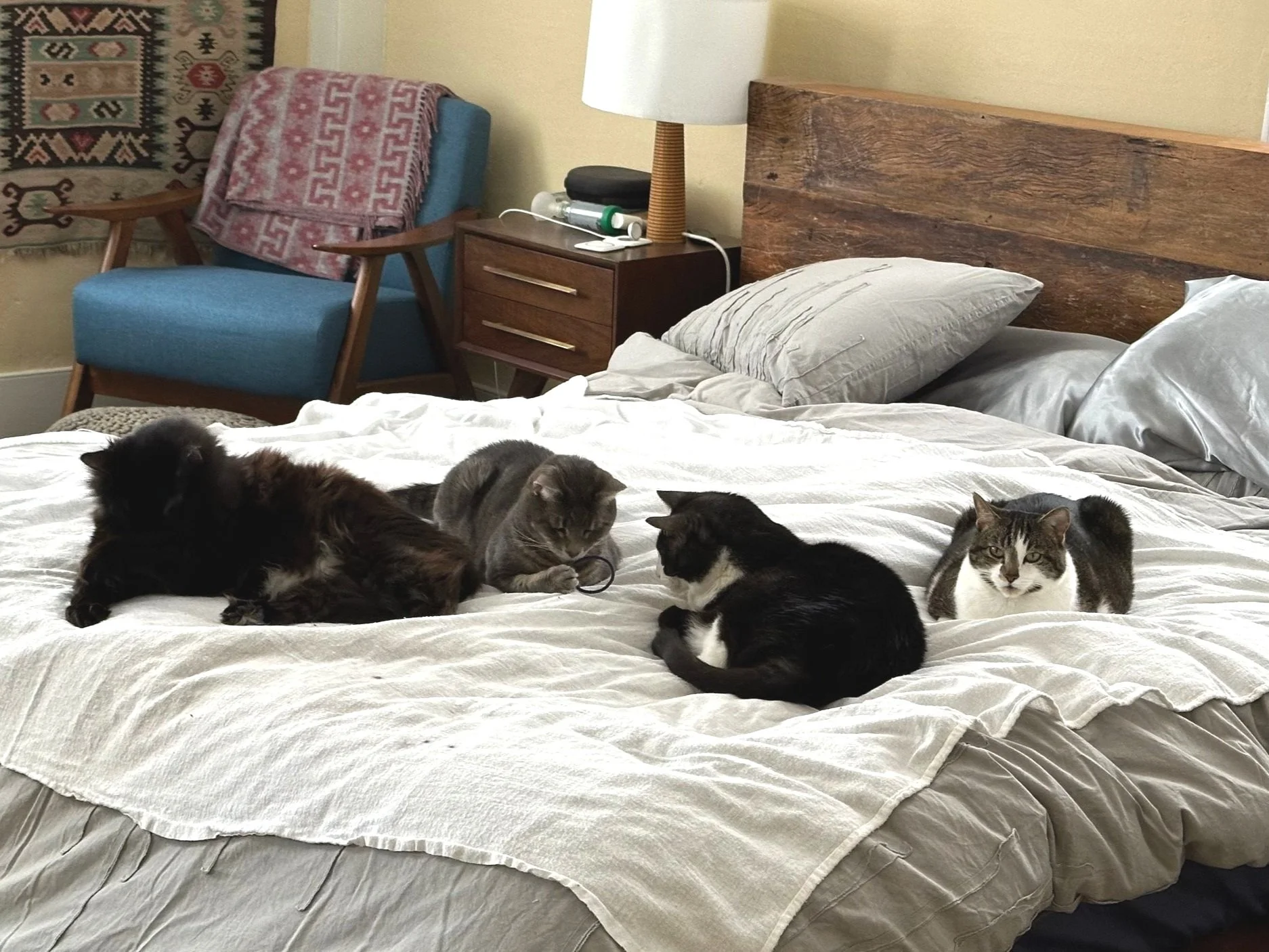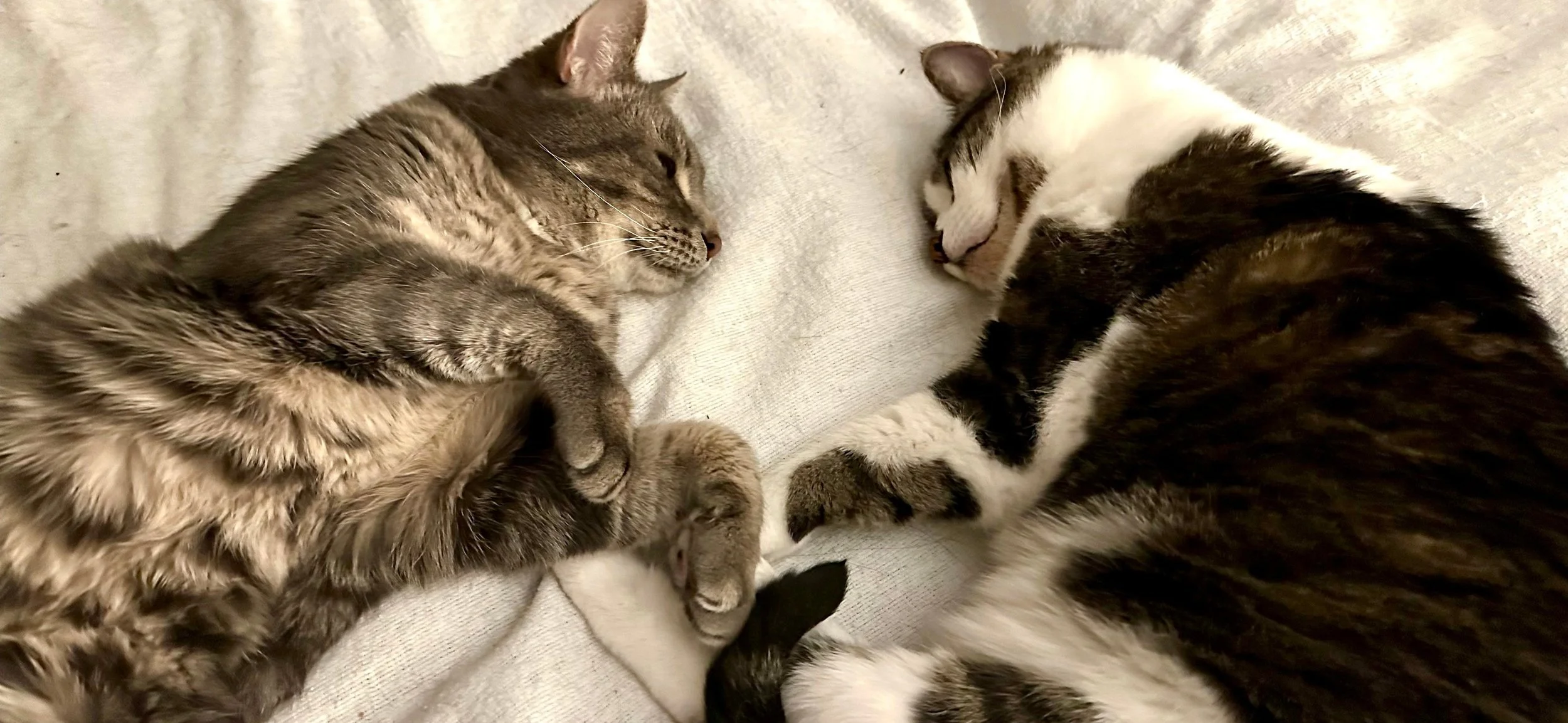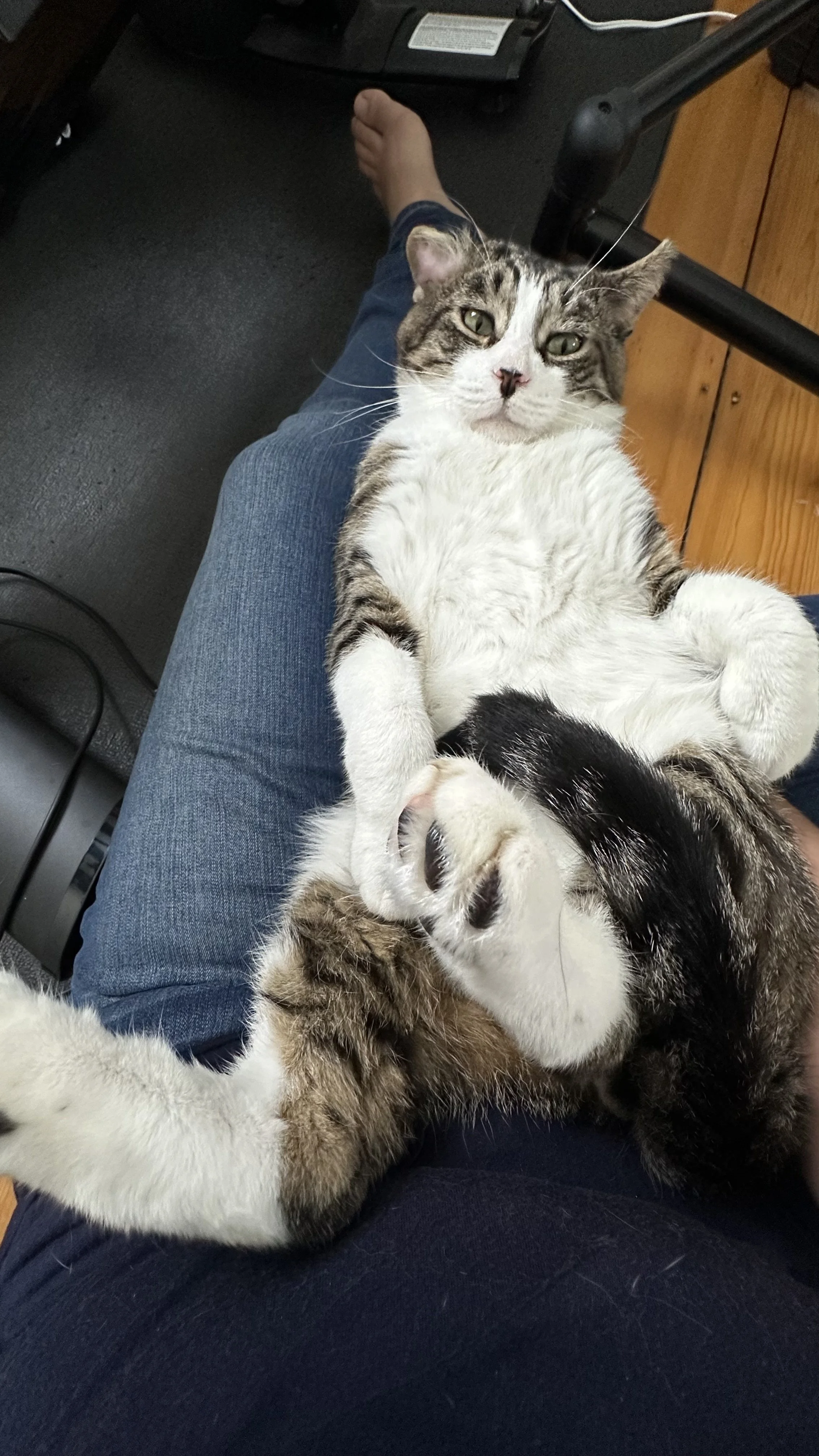Our original crew of four, pictured left to right: Max, Nelson, Niko, and Mena
There Will Be Cats
We’re embarking on a journey in this three-part series: from animal fostering to positive psychology, from Greek mythology to quantum physics. You might be wondering what all of these things have to do with confidence, compassion, and the power of perception. I assure you: they’re all connected.
Let’s begin with two stories about real cats. (We’ll get to Schrödinger’s hypothetical feline later.)
The Story of Ophelia
We recently started fostering for our local animal shelter. It began somewhat accidentally, as it often does with the legendary Cat Distribution System.
Within the last six months, we said goodbye to two of our beloved kitties: Nelson, our cuddly Velcro cat who loved “uppies” and had a deeply insecure attachment style, and Miss Mena, our queen of boundary-setting and belly rubs. That left us with two: Max the Maine Coon (a.k.a. Maximilian Robespierre) and Niko, our tuxedoed Hurricane Harvey survivor. They were well-bonded and balanced, but the house felt too quiet. Too copacetic. We needed some additional fluff to help heal the heartbreak.
Our cuddlebugs Nelson and Mena, whom we said goodbye to over this past year.
So onto the shelter site we went, looking for a young female kitten—someone who would mix up the dynamics without disrupting the peace. We found a profile for a six-month-old black kitten and drove over to meet her.
At the shelter, we were told she was recovering from panleukopenia, a serious viral illness. She’d survived (just barely) but was still contagious and quarantined. The staff warned us: she didn’t like people and wouldn’t let anyone near her. A vet tech demonstrated with a back scratcher and sure enough, was met with a hiss and a swat from the dark hidey hole.
My heart went out to the little void-kitten, clearly scared and unsure.
“Oh, poor thing. She might not be a match for us right now, but what will happen to her? Will someone work with her to socialize?”
The tech shrugged wearily. “She’ll probably end up as a barn cat. You can’t save them all. Nobody wants a project cat.”
My husband and I exchanged a look.
“So,” the tech continued, “any other cats you want to meet?”
We wandered around and met a regal sweet potato of a tailless calico. She meowed at us through the glass and demanded belly rubs. Clearly, we’d been chosen. We signed the adoption paperwork and headed home, but agreed to check on the kitten again once her quarantine ended. I wasn’t convinced she was a lost cause.
(More about our plump calico potato cat, Octavia in a future post…)
Two weeks later, the kitten was still at the shelter, still no adoption inquiries. I asked again about socialization. A super supportive staff member suggested we could try fostering her ourselves. If she improved, great. If not, at least she’d get a break from the shelter.
We watched the training, brought her home, and set her up in her new foster digs.
Little Ophelia, supervising office activities
Within an hour, she was purring.
Within a day, she was nuzzling us for pets.
Within a week, she was fully integrated into the crew, adoption fee paid, and her new name, Ophelia, had been added to the pet insurance.
Now, when she drags her favorite string toy up the stairs to our bedroom, my husband and I grin at each other: “Can’t save ’em all!” When she snuggles up for comfort, we laugh: “Nobody wants a project cat!”
All it took was time, patience, and a little curiosity. We didn’t “fix” Ophelia. We just gave her a chance to decompress, to feel safe, and to decide when she was ready. And what we got in return was a playful, affectionate, deeply sweet kitten.
The Story of Mr. Twisty
Being foster volunteers means we get the email blasts about animals needing placement. Because of the tiny risk of lingering panleukopenia, we were limited to fostering fully vaccinated adult cats. When the shelter reached capacity during kitten season, there was just one candidate who met the criteria: Mr. Twisty.
A three-year-old tabby with a bite of unknown origin, Mr. Twisty was under mandatory rabies quarantine for four months. He wasn’t adapting well to the shelter, and staff warned us he would need space, quiet, and a very slow approach. He might never be a fully domestic cat, they said, but couldn’t be placed as a “barn cat” until quarantine ended.
So Mr. Twisty, with his big tomcat cheeks and wary gaze, moved into our foster room.
We barely saw him for days. He hid. We gave him space, sometimes sitting quietly in the room to read or do the crossword, allowing him to observe us from the shadows. Gradually, he began venturing out—watching from across the room, then creeping closer for tossed treats.
Three weeks in, he walked up to me and nuzzled my hand. Within a day, he was curled in my lap. Within a week, he was greeting me with chirps and meows, falling asleep against my chest.
Mr. Twisty’s favorite way to get cuddles. And yes, he is truly that big.
The real Mr. Twisty had emerged: affectionate, chatty, and heartwarmingly needy. Underneath the fear and withdrawal was a truly special cat, just waiting for the right moment to feel safe enough to be seen.
Why Tell These Stories?
I’ve been thinking a lot about what happened with Ophelia and Mr. Twisty. Were these “transformations”? Not exactly.
I don’t think they changed so much as revealed themselves. What we witnessed were not personality makeovers, but the unveiling of their true selves once their environment shifted and their needs were met.
Humans aren’t so different.
Especially in the workplace, we see similar dynamics all the time. A new team member might seem withdrawn, reactive, defensive, or even overly eager to please. But these aren’t fixed traits. They’re responses to uncertainty and stress. When someone doesn’t feel safe or seen, they adapt. They mask. They protect. And what we see in those early moments (just like at the shelter) isn’t necessarily who they are. It’s who they’re required to be under threat.
This is where positive psychology offers a helpful lens: research shows that we need psychological safety to access our creativity, connection, and confidence. Barbara Fredrickson’s Broaden-and-Build Theory describes how positive emotional states (like curiosity, security, and compassion) expand our capacity for growth, while fear and stress narrow it.
Yet in many workplaces, we operate with a sink-or-swim mentality. “You’ve got to be tough to make it here.” Support is conditional, offered only after someone has proven themselves. Just like at the shelter, it’s easy to justify the stance: limited resources, limited time. “You can’t save them all.”
But at what cost?
How many innovative thinkers, empathetic collaborators, or steady leaders never get the chance to emerge simply because we misinterpret fear as failure, and defensiveness as a lack of capability?
What if we invested just a little more patience? What if we replaced judgment with curiosity? Asked, “What does this person need right now to feel safe enough to try?”
Sometimes it’s time. Sometimes it’s a small accommodation. Often, it’s simply compassion.
As we’ll explore in Part 2, confidence isn’t innate. It’s cultivated. And often, what unlocks someone’s potential isn’t pressure, but rather the power of patience, curiosity, and compassion.
Interested in Fostering?
If this story piqued your interest in fostering or possibly volunteering at your local shelter, there are plenty of ways to get involved at a variety of different levels of commitment or capacity. Perhaps you can visit the shelter and help socialize animals that are awaiting a home. Maybe you’re ready to go all-in and take in a batch of bottle babies.
Most shelters and established rescues will support you with training, resources, and supplies if you do decide to foster.
Chewy has a great resource to help find nearby shelters and rescues.
The Pedigree Foundation also has a searchable directory as part of their Foster 50 Challenge.
You might be the person that helps unlock an amazing opportunity for a beloved-pet-in-the-making. 💜




